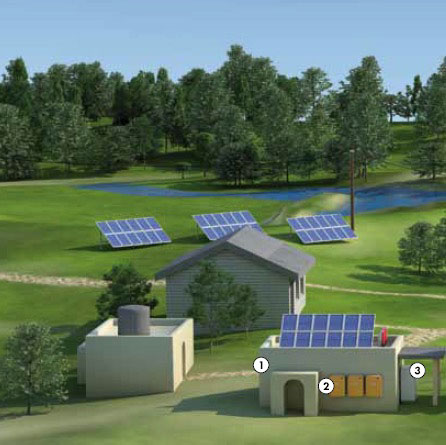P.U.R.E., s. r. o.
DownloadsI'm interested

(Grid free island systems)
The system consists of PV modules, ground-mounting systems, DC cables, inverters, AC cables, DC/AC boxes, island inverters and multi-cluster boxes. The system is designed to be installed in a place with no grid connection. The island inverters create their own grid and supply consumers.
Example:Price calculation of 100 kWp off-grid PV plant
| €/Wp | € | |
|---|---|---|
| Monocrystalline modules, 250 Wp, 400 pcs. | 0,33 | 33 000 |
| Off-grid Inverters, chargers | 0,21 | 21 000 |
| DC cables, AC cables, Multicluster box, other material | 0,13 | 13 000 |
| Free standing construction | 0,14 | 14 000 |
| Batteries KISEN 200 kWh 600V, Li-ion | 0,55 | 55 000 |
| Montage | 0,16 | 16 000 |
| Engineering, project | 0,10 | 10 000 |
| Total turnkey solution | 1,62 | 162 000 |
| Energy yield: | 1 500 - 2 000 KWh/year |
| System guarantee: | 2-5 years |
| Modul power guarantee: | minimum 90% output in 12 years |
| minimum 80% output in 25 years |
Standalone Solar Power Systems are completely independent from any electric utility grid. They are most often used in remote areas where electricity is not available or where the connection fees of the grid are higher than the cost of an alternative energy system. Standalone solar systems (also known as autonomous, or off grid systems) are used to collect and store solar energy to be used by household appliances. These systems typically generate from 100 Watts (very small systems) to 5 kilowatts (larger systems, multi family homes) up to 1 MW (using in the industry). During the day the electricity generated is used to power the home and charge the batteries. At night, and during rainy days, all necessary power is provided by the batteries.
In some cases, where it is important that power is always available, some stand alone systems, known as PV-hybrid systems or island systems, may also have another source of power such as a wind turbine, bio-fuel or a diesel generator.
Power generated from a stand alone system is considered DC (direct current), and is stored in a batteries and converted to AC (alternate current). Standalone Solar Power Systems are the perfect choice for remote rural or villages to provide continuous reliable power.
Solar modules are only one part of a standalone solar system. They work together with other components such as batteries, bi-directional inverters, transformers, etc. Together with power distribution panels and metering devices they complete the process.
The DC electricity produced by the solar panel or module(s) is used to charge batteries via a solar charge controller. Any DC appliances that are connected to the battery will need to be fused. DC lights are normally connected to the charge controller. Any AC appliances are powered via an inverter connected directly to the batteries. Most standalone solar systems need to be managed properly. Users need to know the limitations of a system and tailor energy consumption according to how sunny it is and the state of charge (SOC) of the battery.
The solar panels need to be configured to match the system DC voltage, which is determined by the battery. System voltages are typically, from 12V DC to 48V DC, larger systems will operate at 400 - 800 V DC.
The operating voltage of a solar panel in a stand-alone system must be high enough to charge the batteries. For example a 12V battery will require 14.4V to charge it. The solar panel must be able to deliver this voltage to the battery after power losses and voltage drop in the cables and charge controller and in conditions in which the solar cells operate at a high temperature. A solar panel with a Voc of about 20V is required to reliably charge a 12V battery.
A charge controller is designed to protect the battery and ensure it has a long working life without impairing the system efficiency. Batteries should not be overcharged and the function of the charge controller is to ensure that the battery is not over charged. Charge controllers are designed to function as follows:
The power requirements of standalone solar systems are rarely in sync with the battery charging. Appliances and loads need to be powered when there is sufficient solar radiation, during overcast weather and during the night. Bad weather may last for several days and the daily charging and discharging of the batteries takes its toll on them. Batteries that are able to handle the constant charging and discharging are known as deep cycle batteries. Batteries need to have a good charging efficiency, low charging currents and low self-discharge.
The Ah efficiency of a battery describes the relationship between the Ah that are put into the battery and the Ah that are taken out. Under ideal conditions a new deep-cycle battery would be 90% efficient.
The important characteristics to look for are:
Cables need to be UV resistant and suitable for outdoor applications. It is very important to keep power losses and voltage drop in the cable to a minimum. It is recommended that this be less than 3% between the the array and the batteries and less than 5% between the battery and DC loads.